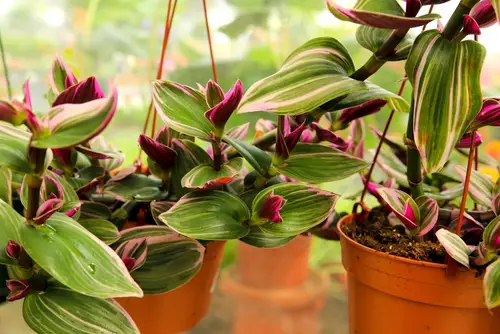Tradescantia Nanouk is a stunning houseplant with a unique appearance that makes it a popular choice for indoor gardening enthusiasts. However, it can be disheartening to see the leaves of your Tradescantia Nanouk turning brown.
Brown leaves can be a sign of several issues, including low humidity, overwatering, or too much direct sunlight.
Understanding the reasons behind brown leaves is the first step in addressing the issue. Tradescantia Nanouk is a tropical plant that requires specific growing conditions to thrive. This plant is sensitive to overwatering, and its leaves can turn brown if the soil is too wet.
Additionally, low humidity can cause the leaves to dry out and turn brown. Too much direct sunlight can also cause the leaves to become scorched and brown.
Key Takeaways
- Brown leaves on Tradescantia Nanouk can be caused by low humidity, overwatering, or too much direct sunlight.
- Providing ideal growing conditions, such as well-draining soil, bright but indirect sunlight, and high humidity, can prevent brown leaves.
- Proper care, including regular watering, pruning, and fertilizing, and propagation can help keep your Tradescantia Nanouk healthy and vibrant.
Learn more about plant care from these other posts:
Understanding Tradescantia Nanouk
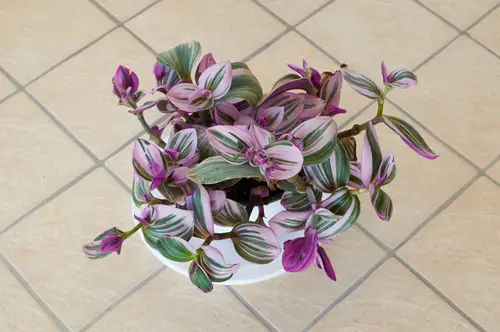
Tradescantia Nanouk is a popular houseplant that is native to Central and South America. It is a patented plant that was developed in the Netherlands, under the name “Fantasy Venice”. It is a member of the Tradescantia family, which is known for its colorful foliage and easy-to-care-for nature.
The Tradescantia Nanouk is a low-maintenance plant that is great for beginners. It is a fast-growing plant that can quickly fill up a pot and produce a lush, trailing display. However, it is important to note that the plant is sensitive to overwatering and can develop root rot if the soil is too moist.
One of the most common issues that owners of Tradescantia Nanouk face is browning leaves. This can be caused by a variety of factors, including low humidity, too much direct light, or underwatering. It is important to monitor the plant’s environment and adjust care accordingly to prevent browning.
Ideal Growing Conditions for Tradescantia Nanouk
Tradescantia Nanouk is a beautiful and easy-to-care-for plant. However, if the plant’s leaves are turning brown, it may be an indication that the growing conditions are not ideal. Here are some of the ideal growing conditions for Tradescantia Nanouk.
1. Light Requirements
Tradescantia Nanouk prefers bright, indirect light. Direct sunlight can scorch its leaves, causing them to turn brown. If the plant is not getting enough light, its leaves may turn green instead of the vibrant pink, purple, and green colors that it is known for. Therefore, it is essential to place the plant near a window that receives sufficient light.
2. Watering Needs
Watering is a crucial aspect of caring for Tradescantia Nanouk. Overwatering can lead to root rot, while underwatering can cause the leaves to turn brown and crispy. The plant should be watered when the top inch of soil is dry. It is essential to water the plant thoroughly and allow the excess water to drain out of the pot.
3. Temperature and Humidity Preferences
Tradescantia Nanouk prefers a temperature range of 60-75°F (16-24°C). The plant also thrives in a humid environment, with a humidity level of 40-60%. In dry environments, the leaves may turn brown and crispy. Therefore, it is essential to keep the plant away from air conditioning vents and heaters that can dry out the air.
Why Is Your Tradescantia Nanouk Turning Brown – 3 Common Problems
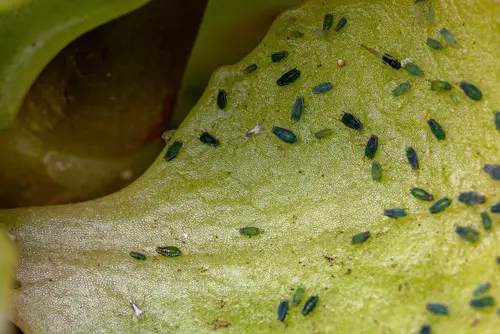
1. Brown Leaves and Spots
One of the most common problems with Tradescantia Nanouk is brown leaves and spots. Brown and crispy leaf edges are usually due to underwatering, air that is too dry, or too much direct light.
If the leaves are turning brown and soft/mushy, it is likely root rot, which is caused by overwatering. Low humidity or dry air can also cause brown spots on the leaves.
To fix the issue, it is important to ensure that the plant is not underwatered or overwatered. It is recommended to water the plant only when the soil is dry in 1 to 2 inches. Pinch your finger in the soil to understand the condition properly.
Remove the brown leaves to prevent further spread of the issue. Maintaining proper humidity levels can also prevent brown spots from forming.
2. Root Rot and Overwatering
Root rot is a common issue with Tradescantia Nanouk. It is caused by overwatering, which leads to the roots becoming waterlogged and unable to absorb nutrients properly. Root rot can cause the leaves to turn brown and mushy.
To prevent root rot, it is important to ensure that the plant is not overwatered. Water the plant only when the soil is dry in 1 to 2 inches. Ensure that the pot has proper drainage to prevent water from accumulating at the bottom of the pot. If the root system is damaged, uproot the plant and transplant it to another pot.
3. Pest and Disease Management
Tradescantia Nanouk is susceptible to pests and diseases such as spider mites, aphids, and mealybugs. These pests can cause brown spots, browning, and crispy leaves. Insect attack can also cause pathogens to enter the plant, leading to diseases.
To manage pests and diseases, it is important to regularly inspect the plant for signs of infestation. Use insecticidal soap or neem oil to get rid of pests. Remove infected leaves to prevent further spread of the disease. Ensure that the plant has proper air circulation to prevent the growth of pathogens.
Care Tips for Tradescantia Nanouk
Tradescantia Nanouk is a beautiful houseplant that can add a pop of color to any room. However, it can be frustrating when the leaves start to turn brown. Here are some care tips to keep your Tradescantia Nanouk healthy and thriving.
1. Soil and Potting
Tradescantia Nanouk prefers well-draining soil and a pot with drainage holes. The plant can quickly suffer from root rot if it sits in water for too long. A good potting mix for Tradescantia Nanouk is one that contains peat moss, perlite, and vermiculite.
2. Watering and Moisture
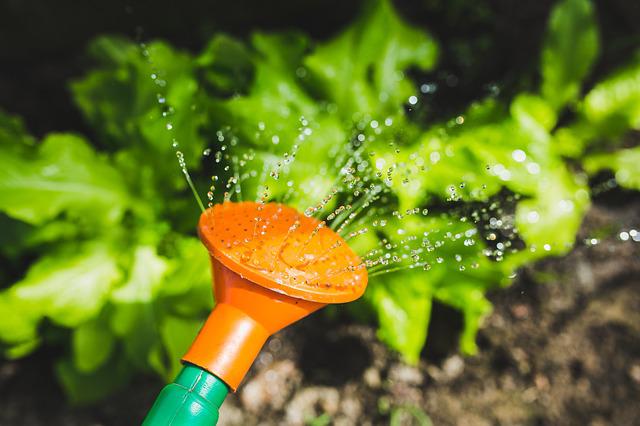
Overwatering is one of the most common reasons why Tradescantia Nanouk leaves turn brown. The plant prefers to be kept moist, but not soggy. It is best to water the plant when the top inch of soil is dry. Avoid getting water on the leaves, as this can cause brown spots.
3. Pruning and Repotting
Pruning is essential for keeping Tradescantia Nanouk healthy and bushy. Trim leggy stems and remove any brown or damaged leaves. Repotting should be done every year or two, depending on how quickly the plant outgrows its pot.
4. Humidity and Misting
Tradescantia Nanouk prefers high humidity and may suffer in low humidity environments. A humidifier or pebble tray can help increase humidity levels. Misting the leaves can also help, but avoid misting the plant too much, as this can lead to fungal growth.
5. Light and Sun Damage
Tradescantia Nanouk prefers bright indirect light and can tolerate some direct sunlight. However, too much sunlight can cause sun damage, which can lead to brown spots on the leaves. If the plant is getting too much light, move it to a shadier spot.
6. Fertilizer and Neem Oil
Tradescantia Nanouk benefits from regular fertilization during the growing season. Use a balanced liquid fertilizer every two weeks. Neem oil can be used to treat insect infestations, but be sure to dilute it properly and avoid using concentrated neem oil, as this can burn the leaves.
7. Diseases and Toxicity
Tradescantia Nanouk can be susceptible to mealybugs and other pests. Insecticides and industrial fungicides and bactericides can be used to treat infestations. The plant is also toxic to cats and dogs, so keep it out of reach of pets.
By following these care tips, you can keep your Tradescantia Nanouk healthy and beautiful. If you notice leaves turning brown, act quickly to treat the problem and rescue your plant.
Propagation of Tradescantia Nanouk
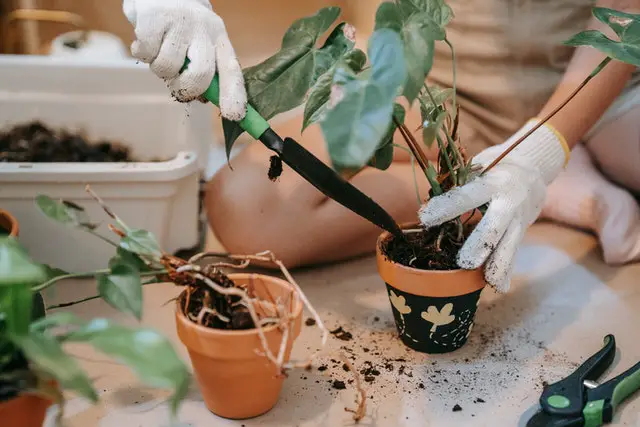
Tradescantia Nanouk is a relatively easy plant to propagate. Propagation is a great way to create more plants and to keep your existing plant bushy and full. The best time to propagate Tradescantia Nanouk is in the spring or summer when the plant is actively growing.
One way to propagate Tradescantia Nanouk is through stem cuttings. To take a stem cutting, simply cut a section of stem just below a node. Nodes are the points on the stem where leaves emerge.
Make sure the cutting is at least three inches long and has several leaves attached. Remove the leaves from the bottom of the stem so that you have a bare stem to insert into the soil.
Dip the cut end of the stem into rooting hormone powder to encourage root growth. Then, insert the stem cutting into a pot filled with moist potting soil. Keep the soil moist and place the pot in a bright, indirect light.
After a few weeks, the cutting should start to develop roots. You can gently tug on the stem to check if it has rooted. Once the cutting has rooted, you can transplant it into a larger pot.
Another way to propagate Tradescantia Nanouk is through division. To divide the plant, carefully remove it from its pot and gently separate the roots into two or more sections. Each section should have a few stems and leaves attached.
Plant each section in its own pot filled with fresh potting soil. Water the newly potted plants and place them in a bright, indirect light. Propagation is a great way to keep your Tradescantia Nanouk healthy and full. With a little care and patience, you can create a whole collection of these beautiful plants.
Frequently Asked Questions
What are the signs of overwatering Tradescantia?
Overwatering is one of the common issues with Tradescantia Nanouk, and it can cause the leaves to turn brown and wilt. Signs of overwatering include yellowing leaves, mushy stems, and a foul odor coming from the soil.
If you notice these signs, it’s important to reduce watering and let the soil dry out before watering again.
What are the common issues with Tradescantia Nanouk?
The most common issues with Tradescantia Nanouk are overwatering, underwatering, low humidity, too much direct sunlight, and pests. Overwatering can cause root rot and brown leaves, while underwatering can lead to dry and crispy leaves.
Low humidity can cause brown leaf edges, while too much direct sunlight can cause sunburned leaves. Pests like spider mites and mealybugs can also cause damage to the plant.
How can I prevent my Tradescantia Nanouk from turning brown?
To prevent your Tradescantia Nanouk from turning brown, make sure to water it properly. Allow the soil to dry out slightly before watering again, and make sure the pot has good drainage.
Keep the plant in a location with bright, indirect sunlight, and maintain a humidity level of 40-60%. Regularly inspect the plant for pests and remove any damaged leaves.
Why do Tradescantia leaves develop brown spots?
Tradescantia leaves can develop brown spots due to a variety of reasons, including low humidity, overwatering, pests, and fungal diseases.
Make sure to maintain a humidity level of 40-60%, avoid overwatering, and regularly inspect the plant for pests. If you notice brown spots, remove the affected leaves and treat the plant with a fungicide.
What is the best way to propagate Tradescantia Nanouk?
The easiest way to propagate Tradescantia Nanouk is through stem cuttings. Take a stem cutting with a few leaves and place it in a jar of water or a well-draining potting mix.
Keep the cutting in a bright, indirect location and mist it regularly to maintain humidity. Once the roots have developed, transplant the cutting into a pot with well-draining soil.
How often should I mist my Tradescantia Nanouk plant?
Tradescantia Nanouk prefers a humid environment, but it’s important not to over-mist the plant, as this can lead to fungal diseases. Misting once or twice a week should be sufficient to maintain the humidity level.
Alternatively, you can place a tray of pebbles filled with water underneath the pot to increase humidity.

Hey, I’m Lisa and I’ve been an avid gardener for over 30 years. I love writing, talking and living in the garden! Feel free to connect with me on my socials below

